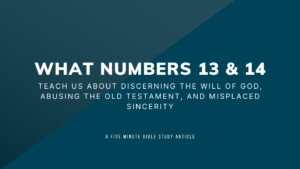This article is the birth child of the one I wrote last week entitled Why the Local Church Should Not Meet in Home Groups. To review and clarify, there is a question of whether or not biblical authority exists to allow a local church to divide into small house groups under normal or exceptional circumstances.
Family Worship V. Corporate Worship
Here is where I need to clarify quickly. The “small groups proposal” as it has been dubbed by myself, is not the same thing as what might be called “family worship.” How? Because the “small groups proposal” involves local church leadership organizing assemblies, and/or the small groups assemblies performing acts of corporate worship that can only be carried out when the whole church is come together in one place (i.e.- the Lord’s supper & the collection). Anything less than that just described could simply be called family worship and is not the subject of discussion here. I personally encourage family worship in the home on any and every day of the week; however, be reminded that praise to God in the home is not under any circumstance a substitute for corporate worship and fellowship as the body of Christ come together in one place.
Meeting from House to House
As was introduced, there is a common circulating argument in support of dividing the local assembly (church) into individual assemblies that worship in member’s houses. The argument goes like this-
“The early church was forced to meet from house to house due to persecution; therefore, the church has authority to divide into small house to house assemblies during times of crisis.”
This argument has a nice ring to it, and I believe many if not all who offer this reasoning do so with full integrity. Nonetheless, there is a significant logical fallacy at play in this argument which needs to be reasoned through.
There is no argument with the fact that the early church started worshiping from house to house due to persecution. While the scripture does not expressly state this as the reason for house to house worship, it is safely inferred from examples such as (Acts 12:12). There is no main proof text for the above argument, though many may be thinking of the great persecution in Acts 8 that led to the scattering of the church after the martyrdom of Stephen. While it is true the church was scattered (Acts 8:1), Luke does not record how the church carried on in response to being scattered. The assumption is made that local assemblies (churches) from Jerusalem temporarily divided into small house to house assemblies later to be reunited as one assembly. However, Luke says nothing about such a practice one way or the other. Nothing. To assume this occurred is to assume too much in light of other scriptures discussing assemblies and worship.
The Acts 12:12 Church
In Acts 12:12 Luke records Peter coming to the house of Mary after being miraculously freed from prison. Luke says that in Mary’s house, “Many were gathered together praying.” We cannot say for sure that this was the local church gathered in Mary’s house or just a group of individual Christians; but suppose it was a local church for just a moment. These Christians were meeting behind closed doors because of the persecution of Herod and the Jews. This very well could have been one of the dispersed groups from Acts 8:1. If it was one of those groups, here is what we can safely assume based on the scriptural definition of a local congregation. This group was fully autonomous from any other congregation. They had biblical leadership in place (Eph. 4:11; Acts 14:23; Titus 1:5). They had a gospel program (Matt. 28:19). They had a treasury (Acts 6:1). They assembled together in one place weekly to commune, take up a collection, and offer corporate worship to God (1 Cor. 11:18; 11:23-26; 14:23; 16:1-2; Acts 2:42). They had all things in common as much as was possible (Acts 4:32). See Clint De France’s sermon The Congregation for an excellent presentation on what constitutes a scriptural congregation of Jesus Christ. To assume that the Acts 12:12 example (if it was indeed a congregation) was anything less than that just stated is to assume something the Bible never speaks to.
Temporary Division
The small groups argument under consideration assumes that meeting from “house to house” implies the church is temporarily divided into sub-assemblies later to be reunited into one assembly. This describes the Bible class model. Any temporary division of the local assembly organized by church leadership and/or incorporating acts of corporate worship (i.e.- communion, collection) fits the Bible class mold, make, and model. Here are three viable courses the dispersed churches of Acts 8:1 could have scripturally taken. 1) The local church stopped meeting publicly and started meeting privately with everyone assembled together in one place. 2) The local church divided into several groups, those groups going off to form new and permanent congregations of the Church of Christ with all the identifying characteristics of a scriptural congregation. 3) The local church was scattered like bugs exposed to light, with individual members going weeks without assembling and communing until they could either be reunited as one body or a new and autonomous congregation established. All of these options would be in keeping with God’s instruction for the local church, particularly in times of crisis. If the local church is ever in a circumstance where the God ordained leadership of that church cannot call a unified assembly of the church for corporate worship, the church is simply left to do nothing (as far as assembling goes) until the circumstances change or the church moves to a new environment.
Conclusion– Much has been said in this study and the last about the lack of authority for the Bible class model; however, nothing has been given in the form of proof texts to this fact. In the next article continuing this discussion, five proofs and associated scriptures will be given showing the Bible class model and small groups model to be unscriptural. Again, I want to end this dry and straightforward delivery by emphasizing the spirit of love motivating such an effort. I pray that if you disagree or have questions you will reach out to me privately and deliver them personally. May all the Lord’s local churches be blessed. Amen.
For Part 3 in this series, click Here > Five Considerations for the Bible Class Model



